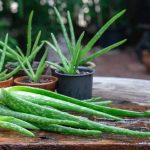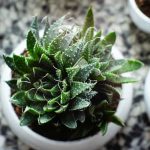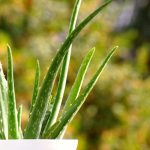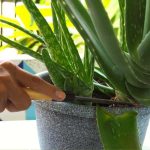Considering adding aloe vera to your garden but unsure about their potential size? The growth of these succulents is influenced by various factors. In this piece, gardening enthusiast Emily Horn delves into the typical size of aloe vera plants and reveals their growth potential.
Cacti & Succulents
How Large Can Aloe Vera Plants Grow?
Before adding a new plant, such as aloe vera, to your indoor collection, ponder upon the question of its growth potential. It’s a common scenario to realize the extent of growth after bringing the plant home.
Once the plant is at home, limited options remain if you haven’t prepared for its growth. Understanding the growth rate and size of aloe vera is crucial.
So, how big do aloe vera plants get? Is it possible to manage their size effectively? Implementing specific methods can help maintain the growth of your aloe vera plant within desired limits.
In Brief
Under standard home conditions, aloe vera typically reaches a height of 2 feet. To control its size, consider regular pruning, adequate indirect light, avoiding excessive fertilization, and infrequent repotting. These practices can help keep your aloe plant compact without compromising its health.
A Detailed Insight
Providing an optimal environment for your aloe plant will generally lead to increased growth. As most people don’t live in desert conditions, the plant may eventually outgrow its space, posing a challenge.
However, fret not! There are simple strategies to manage its growth effectively. These methods are easy to follow and require minimal time and effort, some needing annual attention. Explore these techniques to prevent your plant from overpowering its surroundings.
Trimming

Pruning becomes essential as the plant matures. Additional plants, known as pups, tend to sprout alongside the main plant. While this is natural, unchecked growth of these pups can lead to the plant outgrowing its container.
To maintain a manageable size, occasional pruning is necessary. Before trimming, assess the plant’s overall growth. Remove excess pups, but ensure not to remove all of them at once to maintain the plant’s balance.
If despite trimming, the plant remains too large for your space, consider replanting a pup or two in new containers. Once these pups establish roots and show new growth, you can replace the larger plant. You might end up with multiple plants instead of just one!
Lighting Conditions

Aloe vera thrives in bright, indirect light. Such light typically filters through objects rather than directly hitting them. Ideal sources include west and east-facing windows for indirect light.
Southern exposure provides adequate brightness. Ensure the light remains indirect, as excessive direct light can present issues. Aloe plants under bright, indirect light develop sturdiness, compactness, and are less prone to pests and diseases.
Inadequate light levels may cause the plant to elongate as it seeks better lighting. This elongation compromises structural integrity, making the plant susceptible to collapsing under its weight.
Fertilization

Plants thrive on a tailored nutrient regimen for optimal health and growth, with requirements varying widely across species. Aloe vera, in particular, thrives on lower fertilizer quantities compared to high-feed plants. The organic content in the soil mix usually sustains its needs, but periodic fertilization might be necessary as organic matter diminishes over time.
Choose a specialized fertilizer designed for cacti and succulents to supplement your aloe vera’s nutrition adequately. Feed your plant during its growth phase while avoiding fertilization during dormancy, induced by excessive heat or light intensity during summer.
Avoid feeding dormant aloe vera plants as they are inactive, risking root damage from fertilizer salts and nutrient wastage. When overfed, aloe vera exhibits accelerated growth, leading to weak, spindly plants prone to toppling over and pest infestations due to stress from rapid expansion.
Container Sizing
Container size plays a crucial role in managing plant growth effectively. Aloe vera, being a desert plant, tolerates slight root constriction, which aids in preventing overwatering, making frequent repotting unnecessary. Every few years, repotting your aloe provides sufficient nutrition and hydration.
Assess your plant’s size and root system depth when selecting a pot for repotting. Ideally, leave around 1” of space between the plant and the pot’s sides and provide a depth 1 ½-2” greater than the root system’s length. This spacing encourages healthy root expansion without circling or constriction.
An oversized pot can lead to overwatering, promoting water saturation in the soil, causing potential root rot. For decorative containers, consider using them as outer pots by placing your potted aloe inside, ensuring aesthetic appeal without compromising plant health.
Frequently Asked Questions
Aloe Vera and Its Cactus Connection
Despite similar preferences, aloe vera is taxonomically distinct from cacti. While cacti belong to Cactaceae, aloe vera falls under Asphodelaceae. This difference can be likened to the distinction between cats and dogs, both pets but from different families.
Watering Frequency Guidelines
Watering aloe vera depends on various factors, making a specific schedule challenging. Check your plant weekly for signs of dehydration like dry soil, wilted leaves, or light pots. When watering is warranted, ensure thorough hydration, allowing excess water to drain from the pot’s base.
Pot Preferences for Aloe Vera
For any houseplant, opt for pots with drainage to prevent waterlogging. Decorative pots often lack drainage holes, necessitating creative solutions to ensure proper plant care.
Final Thoughts
For successful gardening, it’s vital to choose pots with proper drainage. Many decorative pots are visually appealing but lack functionality, missing essential drainage holes. This oversight can lead to root rot in most plants due to inadequate drainage.
Opt for terracotta or unglazed clay pots when planting cacti or succulents. Their porous nature allows for better airflow around the roots compared to glazed or plastic containers.
Even though aloe vera and cacti share similar growth requirements, aloe falls under the Asphodelaceae family, distinct from the Cactaceae family to which cacti belong. To illustrate, while both cats and dogs are popular domestic pets, they belong to different animal families, Felidae and Canidae, respectively.
Watering frequency for your aloe plant can vary based on several factors. Conduct regular checks, feeling the soil’s dryness, observing leaf condition, and weighing the pot to determine moisture levels. When watering is necessary, ensure thorough watering so that excess water can freely drain out of the pot.






